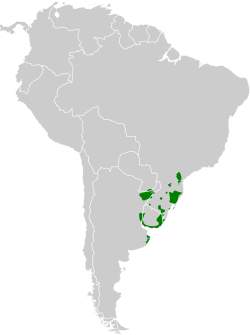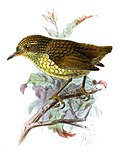Black-and-white monjita
| Black-and-white monjita | |
|---|---|

| |
| A male in Rocha, Uruguay | |
| Scientific classification | |
| Domain: | Eukaryota |
| Kingdom: | Animalia |
| Phylum: | Chordata |
| Class: | Aves |
| Order: | Passeriformes |
| Family: | Tyrannidae |
| Genus: | Heteroxolmis Lanyon, W, 1986 |
| Species: | H. dominicana
|
| Binomial name | |
| Heteroxolmis dominicana (Vieillot, 1823)
| |

| |
| Synonyms | |
|
Xolmis dominicana | |
The black-and-white monjita (Heteroxolmis dominicana) is a species of passerine bird in the family Tyrannidae, the tyrant flycatchers.[2] It is found in Argentina, Brazil, Uruguay and possibly Paraguay.[3]
Taxonomy and systematics
[edit]The black-and-white monjita was formally described in 1823 as Tyrannus dominicanus.[4] It was placed in genus Xolmis through much of the twentieth century. By the 1990s several authors had moved it to the new genus Heteroxolmis.[5][6] The IOC had adopted the change by 2008.[7] The South American Classification Committee of the American Ornithological Society (SACC) and the Clements taxonomy followed suit in 2021.[8][9] However, as of December 2024 BirdLife International's Handbook of the Birds of the World retains the species as Xolmis dominicanus.[10] Because the move of this species and several others from Xolmis resulted in species of several genera being called "monjita", the SACC is seeking a proposal to adopt new English names.[6]
The black-and-white monjita is the only species in the genus Heteroxolmis and has no subspecies.[2]
Description
[edit]The black-and-white monjita is 20 to 20.5 cm (7.9 to 8.1 in) long. Adult males are mostly white. They have pale grayish smudging on the head and back, black wings with white outer thirds of the primaries, a long black tail, and entirely white underparts. Adult females have a brownish gray crown and back, white scapulars, and a white rump. Both sexes have a dark iris, a black bill, and black legs and feet. Juveniles have a rusty back.[11]
Distribution and habitat
[edit]The black-and-white monjita has a patchy distribution. It is found in Brazil's Paraná, Santa Catarina, and Rio Grande do Sul states, in Uruguay, and in northeastern Argentina south to northeastern Buenos Aires Province.[11][12][13] The SACC has unconfirmed records from Paraguay and so calls the species hypothetical in that country.[3]
The black-and-white monjita inhabits a variety of landscapes. It primarily is found in marshes and bogs characterized by Cypernus and Eryngium sedges. It also occurs in open or burned areas and locally on the landward side of coastal sand dunes. It does forage in grasslands adjoining the wetter areas. In elevation it mostly ranges from sea level to 500 m (1,600 ft) but occasionally is found much higher.[11][12]
Behavior
[edit]Movement
[edit]The black-and-white monjita is a year-round resident.[11]
Feeding
[edit]The black-and-white monjita feeds on insects. It perches low down and drops onto prey on the ground. For an unknown reason it often forages with flocks of the saffron-cowled blackbird (Xanthopsar flavus).[11]
Breeding
[edit]The black-and-white monjita's breeding season has not been fully defined but spans at least October to December in Brazil and September to December in Argentina. Its nest is a bulky open cup made from dry grass, coarse stems, and sometimes leaves, and lined with fine grass, feathers, and wool. It typically is hidden in a low bush or in a clump of grass. The clutch is three to four eggs. The incubation period, time to fledging, and details of parental care are not known. The nests are parasitized by the shiny cowbird (Molothrus bonariensis).[11]
Vocalization
[edit]The black-and-white monjita is usually silent but does make a "soft, somewhat querulous weeyrt or wurrt call, especially when agitated".[11]
Status
[edit]The IUCN originally in 1988 assessed the black-and-white monjita as Threatened and since 1994 as Vulnerable. It is found in fewer than 100 locations scattered throughout 957,000 km2 (369,000 sq mi); the area actually occupied is unknown.[1] (It is estimated to be 120,000 km2 (46,000 sq mi).[11]) Its estimated population of between 6000 an 15,000 mature individuals is believed to be decreasing. The principle threat is habitat conversion. "Agriculture, and especially livestock-grazing, has modified grasslands since the 16th century, and intensely since the 1870s. Very recently, afforestation with non-native trees has begun to radically alter remaining grasslands."[1] The species is considered rare to uncommon and very local. It is more common from Rio Grande do Sul south than in the more northern part of its range. "Further threats are destruction of nests by fires and high levels of brood parasitism by Shiny Cowbird." It occurs in many national parks and private reserves.[11]
References
[edit]- ^ a b c BirdLife International (2017) [amended version of 2016 assessment]. "Black-and-white Monjita Xolmis dominicanus". IUCN Red List of Threatened Species. 2017: e.T22700052A118650884. doi:10.2305/IUCN.UK.2017-3.RLTS.T22700052A118650884.en. Retrieved 23 May 2025.
- ^ a b Gill, Frank; Donsker, David; Rasmussen, Pamela, eds. (March 2025). "Tyrant flycatchers". IOC World Bird List. v 15.1. Retrieved 3 March 2025.
- ^ a b Remsen, J. V., Jr., J. I. Areta, E. Bonaccorso, S. Claramunt, G. Del-Rio, A. Jaramillo, D. F. Lane, M. B. Robbins, F. G. Stiles, and K. J. Zimmer. Version 30 March 2025. Species Lists of Birds for South American Countries and Territories. https://www.museum.lsu.edu/~Remsen/SACCCountryLists.htm retrieved 30 March 2025
- ^ Bonnaterre, Pierre Joseph; Vieillot, L. P. (1823). Tableau encyclopédique et méthodique des trois règnes de la nature (in Latin and French). Vol. 2. Chez Mme. veuve Agasse. p. 856. Retrieved 23 May 2025.
- ^ Lanyon, W. E. (1986) "A phylogeny of the kingbirds and their allies" American Museum Novitates 2797: 1–28.
- ^ a b Remsen, J. V., Jr., J. I. Areta, E. Bonaccorso, S. Claramunt, G. Del-Rio, A. Jaramillo, D. F. Lane, M. B. Robbins, F. G. Stiles, and K. J. Zimmer. Version 30 March 2025. A classification of the bird species of South America. American Ornithological Society. https://www.museum.lsu.edu/~Remsen/SACCBaseline.htm retrieved 30 March 2025
- ^ Gill, F. and M.Wright. 2006. Birds of the World: Recommended English Names. Princeton NJ: Princeton University Press Version 1.6 generated on 28 June 2008
- ^ Remsen, J. V., Jr., et al. Version 19 January 2021. A classification of the bird species of South America. American Ornithological Society.
- ^ Clements, J. F. et al. 2021. The eBird/Clements checklist of birds of the world: v2021.
- ^ HBW and BirdLife International (2024). Handbook of the Birds of the World and BirdLife International digital checklist of the birds of the world. Version 9. Available at: https://datazone.birdlife.org/about-our-science/taxonomy retrieved 23 December 2024
- ^ a b c d e f g h i Farnsworth, A. and G. Langham (2021). Black-and-white Monjita (Heteroxolmis dominicana), version 1.1. In Birds of the World (J. del Hoyo, A. Elliott, J. Sargatal, D. A. Christie, and E. de Juana, Editors). Cornell Lab of Ornithology, Ithaca, NY, USA. https://doi.org/10.2173/bow.bawmon3.01.1 retrieved 23 May 2025
- ^ a b van Perlo, Ber (2009). A Field Guide to the Birds of Brazil. New York: Oxford University Press. pp. 320–321. ISBN 978-0-19-530155-7.
- ^ de la Peña, Martín R.; Rumboll, Maurice (2001). Birds of Southern South America and Antarctica. Princeton Illustrated Checklists. New Jersey: Princeton University Press. pp. Plate 75, map 75.5. ISBN 0691090351.



